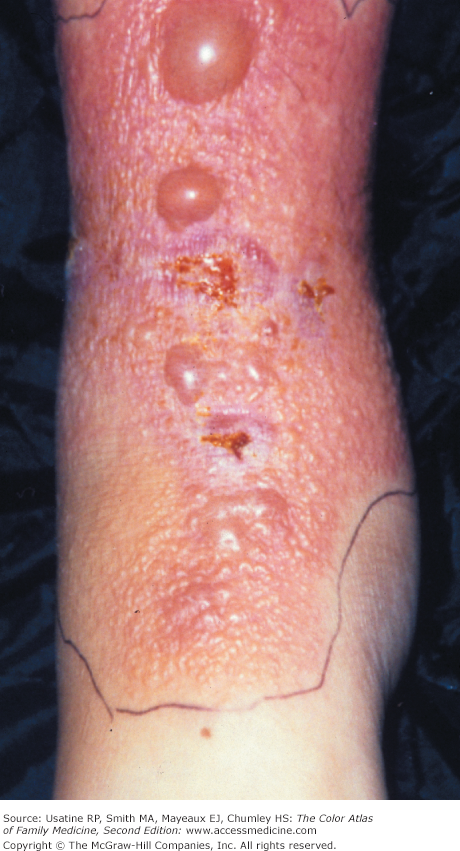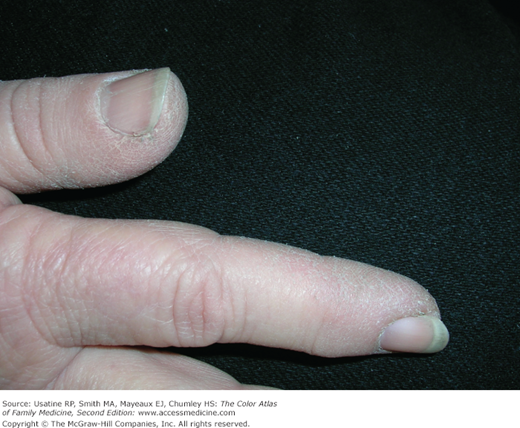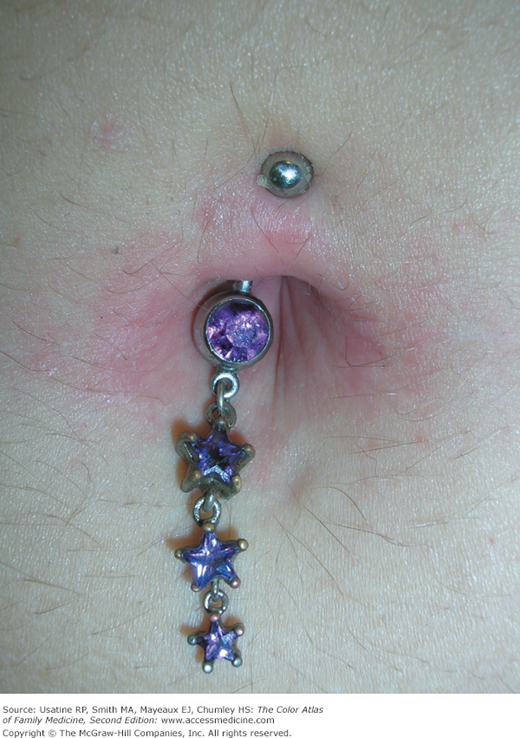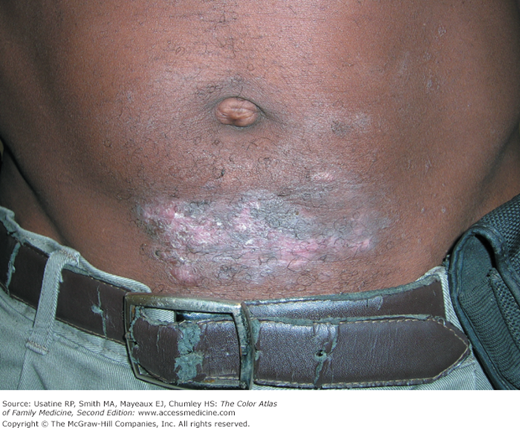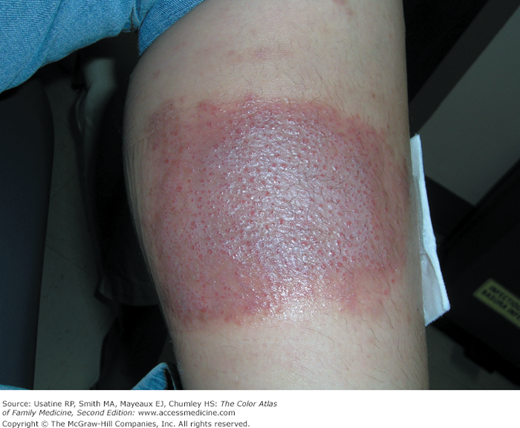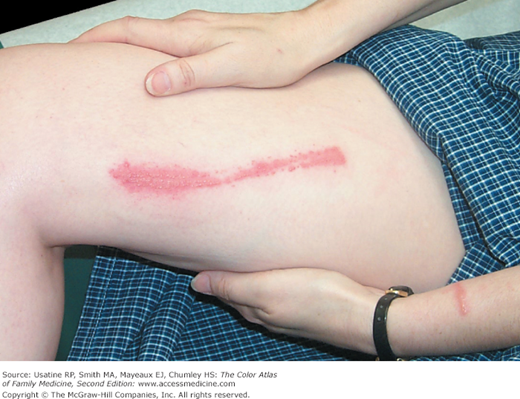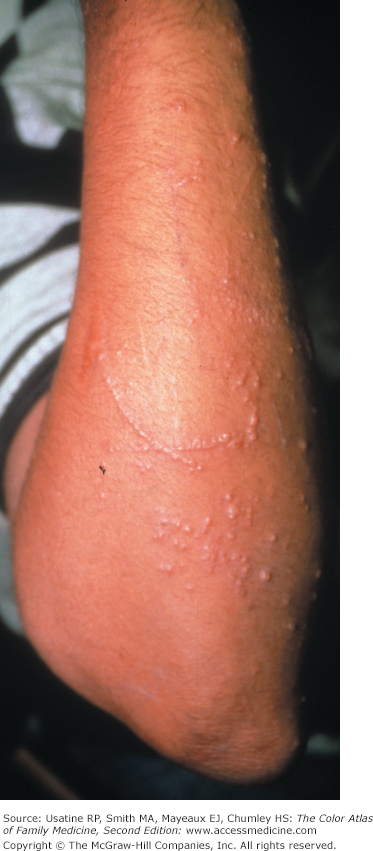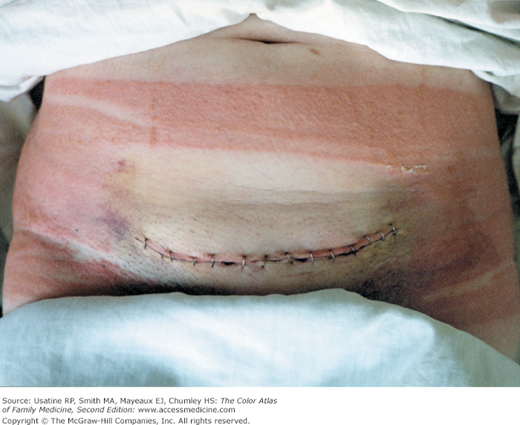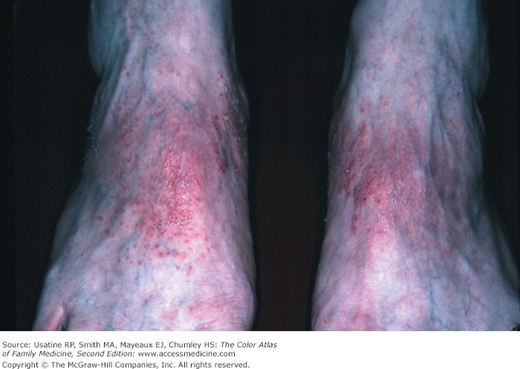Patient Story
A 38-year-old woman twisted her right ankle and applied a Chinese medicine patch to relieve the pain. The following day the patient developed a severe contact dermatitis (CD) with many small vesicles (<5 mm) and bullae (>5 mm) (Figure 146-1). The erythema had a well-demarcated border and was traced by the doctor’s pen. Cold compresses and a high potency topical steroid were prescribed. When the patient showed little improvement a 2-week course of oral prednisone was given starting with 60 mg daily and tapering down to 5 mg daily. The patient responded rapidly and the CD fully resolved.1,2
Introduction
CD is a common inflammatory skin condition characterized by erythematous and pruritic skin lesions resulting from the contact of skin with a foreign substance. Irritant contact dermatitis (ICD) is caused by the non-immune-modulated irritation of the skin by a substance, resulting in a skin changes. Allergic contact dermatitis (ACD) is a delayed-type hypersensitivity reaction in which a foreign substance comes into contact with the skin, and upon reexposure, skin changes occur.3
Epidemiology
- Some of the most common types of CD are secondary to exposures to poison ivy, nickel, and fragrances.4
- Patch testing data indicate that the five most prevalent contact allergens out of more than 3700 known contact allergens are nickel (14.3% of patients tested), fragrance mix (14%), neomycin (11.6%), balsam of Peru (10.4%), and thimerosal (10.4%).5
- Occupational skin diseases (chiefly CD) rank second only to traumatic injuries as the most common type of occupational disease. Chemical irritants such as solvents and cutting fluids account for most ICD cases. Sixty percent were ACD and 32% were ICD. Hands were primarily affected in 64% of ACD and 80% of ICD4 (Figure 146-2).
Etiology and Pathophysiology
- CD is a common inflammatory skin condition characterized by erythematous and pruritic skin lesions resulting from the contact of skin with a foreign substance.
- ICD is caused by the non-immune-modulated irritation of the skin by a substance, resulting in a skin rash.
- ACD is a delayed-type hypersensitivity reaction in which a foreign substance comes into contact with the skin, and is linked to skin protein forming an antigen complex that leads to sensitization. Upon reexposure of the epidermis to the antigen, the sensitized T cells initiate an inflammatory cascade, leading to the skin changes seen in ACD.
Diagnosis
Ask about contact with known allergens (i.e., nickel, fragrances, neomycin, and poison ivy/oak).
- Nickel exposure is often related to the wearing of rings, jewelry, and metal belt buckles (Figures 146-3, 146-4, 146-5, and 146-6).
- Fragrances in the forms of deodorants and perfumes (Figure 146-7).
- Neomycin applied as a triple antibiotic ointment by patients (Figures 146-8 and 146-9).
- Poison ivy/oak in outdoor settings. Especially ask when the distribution of the reaction is linear (Figures 146-10 and 146-11).
- Ask about occupational exposures, especially solvents. For example, chemicals used in hat making can cause ICD on the hands (Figure 146-2).
- Tapes applied to skin after cuts or surgery are frequent causes of CD (Figure 146-12).
- If the CD is on the feet, ask about new shoes (Figures 146-13 and 146-14).
Figure 146-8
Allergic contact dermatitis to neomycin applied to the leg of a young woman. Her mom gave her triple antibiotic ointment to place over a bug bite with a large nonstick pad. The contact allergy follows the exact size of the pad and only occurs where the antibiotic was applied. (Courtesy of Richard P. Usatine, MD.)

